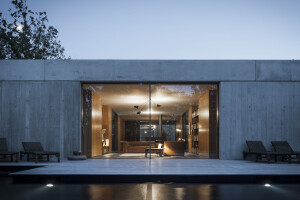“Alpendre” from galician or portuguese alpendre, and these from the latin appendix, ‘something added, accesory”.

The faculty of architecture of CESUGA completed a wood design and build workshop (during the IV Xornadas Internacionais da Madeira 2024), whose main goal was to promote the use of wood as a building material in the forestry region of Galicia, Spain, through education in design and construction techniques.

The workshop started from the opportunity to intervene in the environment near CESUGA: Feáns, A Coruña, a place in transformation that retains a strong identity and great social interaction, as well as environmental and ethnographic value.

The plot, a public park and a civic center in the valley, is an open space, connected to the main road network and a rural path, Camino de Campos, that runs parallel to the river course, an axis of great biodiversity that links the institution with a protohistoric settlement from the 3rd century BC, Castro de Elviña, in a northeast direction. There is a sequence of plots of land along this axis, with agricultural activity.

At first, the suggestions of the neighbors were gathered, and subsequently incorporated into the analysis and discussion. Different locations on the plot and uses were evaluated, with the help of drawings, models and a textile extempore spatial exploration of the site.

The existing building, a one-story prismatic volume containing small multipurpose rooms, is set back from the road, leaving a paved parking space in front and a rear park to the south. It was decided to tackle the most difficult side of the site: this front access sequence, with the parking area.

The installation resulting from the combination of the different proposals studied by the group was a modular structure, with frames being repeated 6 times, rising up to the height of the building's façade and covered with translucent fabrics mainly on its north façade and roof, and partially on its south façade. It was preferred that the fabrics have more presence to the north (highlighting the institution in the distance), and the wooden structure to more be visible on the side facing the building’s facade, creating a shared interior that would be complementary to the access area of the civic center. Between these frames we built platforms at different levels consolidating a support structure for seating and shade and a slightly elevated viewpoint to recognize the surrounding fields and their activity.

Based on previous learning experiences and a minimum planning, the values of manual work linked to a certain degree of improvisation made their way into the fabrication process. The workshop introduced the material, its dimensioning possibilities, and assembly details. The material itself, its logic, rationality and the versatility of the tectonic, modular system that was used, contributed to this learning process. The workshop’s tight schedule also acted as a defining constraint in decision making.

At the end of the workshop, we had carried out a temporary installation that stands simply on the ground (without foundations), an experimental prototype; that is to say, we rehearsed a dialogue between the landscapes that characterize the city of A Coruña: urban, industrial and rural; between the neighbors and their civic center; between an architecture without reference to its geography and a new artifact that tries to act as a mediator and establish some relationship, at least functional or even metaphoric, with the architecture of the region.















































